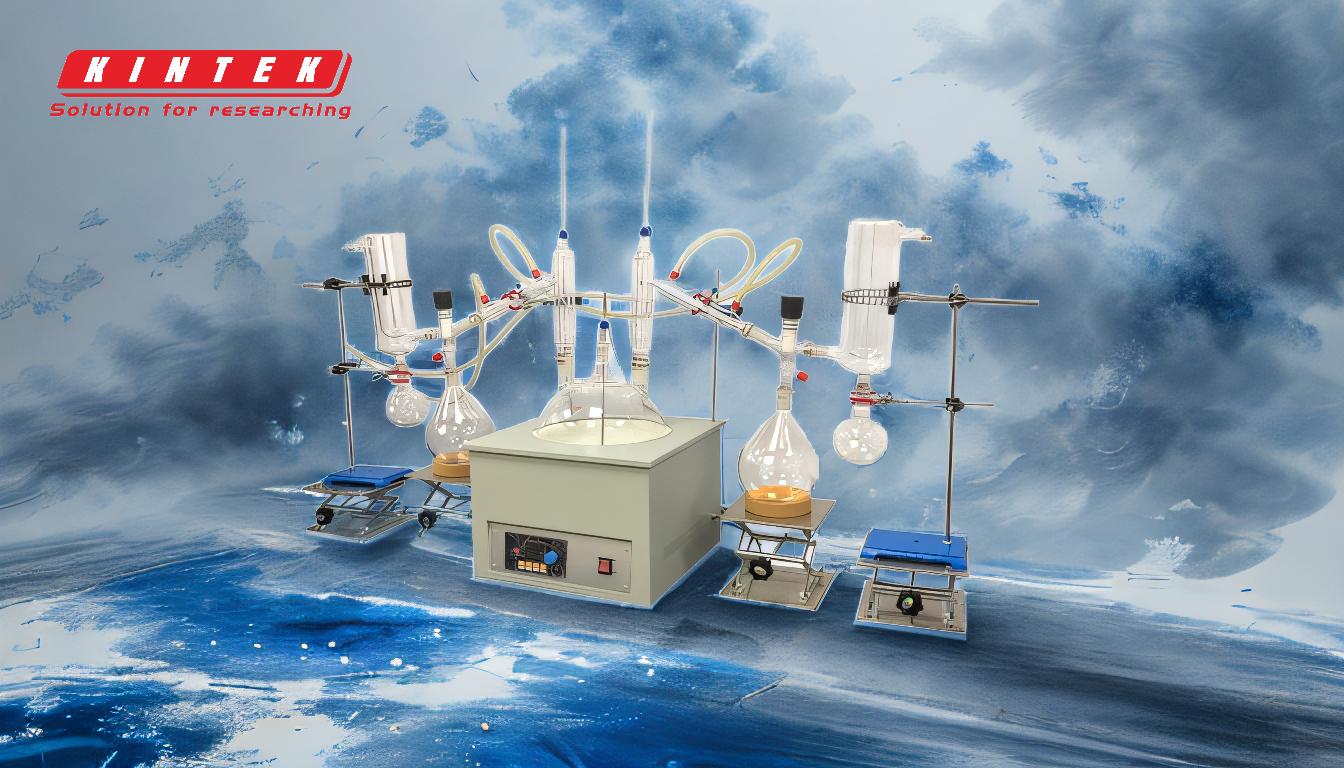Short-path distillation is a specialized technique used for separating and purifying heat-sensitive or high-boiling-point materials. The process involves heating a mixture in a boiling flask under reduced pressure, causing the components to vaporize. The vapors then travel a short distance to a condenser, where they are cooled and collected as separate fractions. This method is highly efficient for isolating specific compounds due to its ability to operate under extremely low pressures and short vapor paths. Below is a detailed explanation of how to use short-path distillation, including setup, operation, and key considerations.
Key Points Explained:

-
Preparation of the Material
- Before distillation, the material must be prepared to ensure optimal separation. This often involves:
- Winterization: Removing waxes and lipids by cooling the material and filtering out the solids.
- Decarboxylation (Decarbing): Activating certain compounds (e.g., cannabinoids) by heating the material to convert acidic forms into their active counterparts.
- Proper preparation ensures that the material is free of impurities and ready for efficient distillation.
- Before distillation, the material must be prepared to ensure optimal separation. This often involves:
-
Assembly of the Short-Path Distillation System
- The system consists of several key components:
- Boiling Flask: Holds the material to be distilled.
- Condenser: Cools the vaporized compounds back into liquid form.
- Receiving Flask(s): Collects the separated fractions.
- Vacuum Pump: Creates the necessary low-pressure environment.
- Heater/Chiller: Controls the temperature of the boiling flask and condenser.
- Steps for assembly:
- Secure all glassware joints, ensuring they are vacuum-tight.
- Apply high-vacuum grease to the joints to prevent leaks.
- Orient the receiving cow (flask) correctly to collect fractions efficiently.
- The system consists of several key components:
-
Setting Up the Vacuum System
- A vacuum is essential for short-path distillation to lower the boiling points of the components and prevent thermal degradation.
- Steps:
- Connect the vacuum pump to the system.
- Allow the system to reach a full vacuum, typically below 50 millitorr.
- Use a vacuum trap filled with dry ice and alcohol to condense any volatile solvents or impurities that may escape.
-
Temperature Control and Heating
- The boiling flask is heated gradually to vaporize the components:
- Start with a low mantle temperature (45–60°C) to prevent over-boiling.
- Gradually increase the temperature while monitoring the vacuum pressure.
- Adjust the vacuum and temperature to ensure smooth vaporization and condensation.
- The condenser is cooled using a chiller or cooling fluid to ensure efficient condensation of the vapors.
- The boiling flask is heated gradually to vaporize the components:
-
Distillation Process
- As the material heats up, components with lower boiling points vaporize first.
- The vapors travel a short distance to the condenser, where they are cooled and collected as liquid fractions.
- The process is repeated at higher temperatures to separate components with higher boiling points.
-
Collection of Fractions
- The receiving flask collects the condensed fractions. Each fraction corresponds to a specific compound or group of compounds based on their boiling points.
- The fractions can be further purified or analyzed as needed.
-
Post-Distillation Cleanup
- After distillation, the system must be cleaned to prevent contamination in future runs:
- Disassemble the glassware and clean it thoroughly.
- Remove any residual grease from the joints.
- Ensure all components are dry before reassembly.
- After distillation, the system must be cleaned to prevent contamination in future runs:
-
Key Considerations for Success
- Vacuum Integrity: Ensure all joints are properly sealed to maintain the required low pressure.
- Temperature Control: Avoid overheating, which can degrade heat-sensitive compounds.
- Fraction Collection: Monitor the process closely to collect fractions at the correct temperatures.
- Material Preparation: Properly winterized and decarbed material yields better separation and purity.
By following these steps, short-path distillation can effectively separate and purify complex mixtures, making it a valuable tool for industries such as pharmaceuticals, essential oils, and cannabis extraction. Its ability to operate under low pressure and short vapor paths ensures minimal thermal degradation and high purity of the final products.
Summary Table:
| Step | Key Actions |
|---|---|
| Preparation | Winterize and decarboxylate the material for optimal separation. |
| System Assembly | Assemble boiling flask, condenser, receiving flask, vacuum pump, and heater. |
| Vacuum Setup | Connect the vacuum pump and ensure pressure drops below 50 millitorr. |
| Temperature Control | Gradually heat the boiling flask and cool the condenser for efficient operation. |
| Distillation Process | Collect fractions based on boiling points for high-purity separation. |
| Post-Distillation | Clean and dry all components to prevent contamination. |
| Key Considerations | Maintain vacuum integrity, control temperature, and monitor fraction collection. |
Ready to optimize your separation process? Contact us today to learn more about short-path distillation systems!










